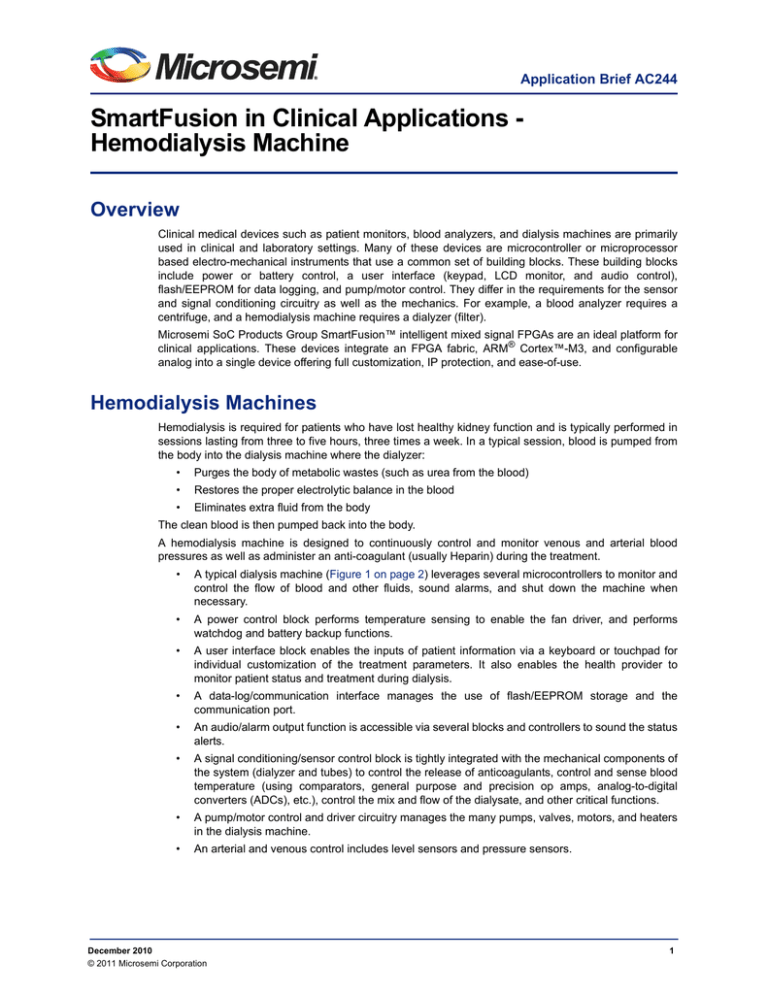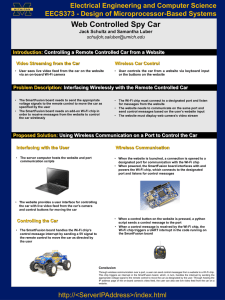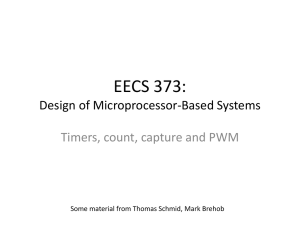
Application Brief AC244
SmartFusion in Clinical Applications Hemodialysis Machine
Overview
Clinical medical devices such as patient monitors, blood analyzers, and dialysis machines are primarily
used in clinical and laboratory settings. Many of these devices are microcontroller or microprocessor
based electro-mechanical instruments that use a common set of building blocks. These building blocks
include power or battery control, a user interface (keypad, LCD monitor, and audio control),
flash/EEPROM for data logging, and pump/motor control. They differ in the requirements for the sensor
and signal conditioning circuitry as well as the mechanics. For example, a blood analyzer requires a
centrifuge, and a hemodialysis machine requires a dialyzer (filter).
Microsemi SoC Products Group SmartFusion™ intelligent mixed signal FPGAs are an ideal platform for
clinical applications. These devices integrate an FPGA fabric, ARM® Cortex™-M3, and configurable
analog into a single device offering full customization, IP protection, and ease-of-use.
Hemodialysis Machines
Hemodialysis is required for patients who have lost healthy kidney function and is typically performed in
sessions lasting from three to five hours, three times a week. In a typical session, blood is pumped from
the body into the dialysis machine where the dialyzer:
•
Purges the body of metabolic wastes (such as urea from the blood)
•
Restores the proper electrolytic balance in the blood
•
Eliminates extra fluid from the body
The clean blood is then pumped back into the body.
A hemodialysis machine is designed to continuously control and monitor venous and arterial blood
pressures as well as administer an anti-coagulant (usually Heparin) during the treatment.
•
A typical dialysis machine (Figure 1 on page 2) leverages several microcontrollers to monitor and
control the flow of blood and other fluids, sound alarms, and shut down the machine when
necessary.
•
A power control block performs temperature sensing to enable the fan driver, and performs
watchdog and battery backup functions.
•
A user interface block enables the inputs of patient information via a keyboard or touchpad for
individual customization of the treatment parameters. It also enables the health provider to
monitor patient status and treatment during dialysis.
•
A data-log/communication interface manages the use of flash/EEPROM storage and the
communication port.
•
An audio/alarm output function is accessible via several blocks and controllers to sound the status
alerts.
•
A signal conditioning/sensor control block is tightly integrated with the mechanical components of
the system (dialyzer and tubes) to control the release of anticoagulants, control and sense blood
temperature (using comparators, general purpose and precision op amps, analog-to-digital
converters (ADCs), etc.), control the mix and flow of the dialysate, and other critical functions.
•
A pump/motor control and driver circuitry manages the many pumps, valves, motors, and heaters
in the dialysis machine.
•
An arterial and venous control includes level sensors and pressure sensors.
December 2010
© 2011 Microsemi Corporation
1
SmartFusion in Clinical Applications - Hemodialysis Machine
Figure 1 is a block diagram for a typical hemodialysis machine.
[
Power Control
Watchdog
Fan
Dialyzer/Filter
Fan Driver
Temp Sensor
Motor/Pump Driver
User Interface
Signal Conditioning /
Sensor Control
Microprocessor
Keypad
Keypad Controller
LCD
LCD Controller
Microprocessor
ADC
Arterial and Venous Control
Motor
Data-Log /
Communication
ADC
Venous
Transducer
Motor
Arterial
Transducer
Memory/NVM
Communication
Interface
Audio/Alarm
Speaker
PWM/DAC
Figure 1 • Hemodialysis Block Diagram
SmartFusion as a Platform for Clinical Medical Devices
SmartFusion devices combine all the features that designers of clinical medical devices require into a
single chip, creating a true programmable system-on-chip (SoC) solution.
The Processor Core
At the heart of a SmartFusion device is an embedded ARM Cortex-M3 processor core. With its hardware
multiplier and divider, this 32-bit RISC processor delivers high performance: about 125 Dhrystone MIPS.
Surrounding the Cortex-M3 core are a number of integrated peripherals: SPI, I2C, and UART serial ports,
up to 512 KB of embedded FlashROM (EFROM), 10/100 Ethernet MAC, timers, phase-locked loops
(PLLs), oscillators, real-time counters (RTCs), and peripheral DMA controller (PDMA). The processor
and its peripherals are interconnected via a multi-layer advanced high-performance bus (AHB) matrix
(referred to as ABM). The ABM also provides the path for the processor and its peripherals to
communicate with both the FPGA fabric and embedded analog functions.
2
SmartFusion as a Platform for Clinical Medical Devices
Programmable Analog
Portable medical designs must interface directly with various bio-sensors. The programmable analog
section or analog front-end (AFE) of a SmartFusion device contains the needed elements such as
analog-to-digital converters (ADCs) and digital-to-analog converters (DACs), along with more advanced
features.
Each SmartFusion device contains up to three 12-bit successive-approximation-register (SAR) ADCs,
capable of operating at 500 Ksps in 12-bit mode (550 Ksps in 10-bit mode and 600 Ksps in 8-bit mode).
To process signals in the other direction, each device comes equipped with one first-order sigma-delta
DAC per ADC, offering an effective 12 bits of resolution at 500 Ksps.
Further enhancing the functionality of the ADCs are up to five high-performance analog signal
conditioning blocks (SCBs) per device. Each SCB comes packed with two high-voltage bipolar monitors
(with 1% accuracy), a high-gain current monitor, a temperature monitor (with 0.25°C resolution), and two
high-speed comparators.
Rather than burden the embedded Cortex-M3 processor with low-level initialization and control of the
AFE, SmartFusion devices include an innovative analog compute engine (ACE). The ACE operates as a
second processor and can, for example, automatically adjust the resolution of the ADCs sample by
sample, or after a preset amount of time. The engine can also automatically increase or decrease ADC
resolution over time, or delay the samples from one ADC channel to another. In addition, the engine can
perform linear, digital low-pass filtering, threshold comparison, or state filtering independent of the
embedded processor.
Flexible FPGA Fabric
Accessible to both the microcontroller subsystem and the analog compute engine is the SmartFusion
fabric. Based on proven ProASIC®3 flash FPGA architecture, the SmartFusion fabric provides the user
with up to half million system gates worth of logic plus up to 108 Kbits of embedded RAM.
This highly flexible fabric can communicate with the microcontroller subsystem via the AHB bus matrix.
Because the fabric can act as either a slave or master to the bus, functions implemented in the fabric can
be slaved to the processor. Likewise, the various peripherals in the MSS can be accessed from functions
in the fabric, allowing certain low-level tasks to be offloaded from the processor. Similarly, the functions in
the fabric have direct access to the ACE.
These abundant resources are available to the user to build additional peripherals and custom functions.
Users also have access to the SoC Products Group's DirectCore library of more than 50 different IP
blocks and can obtain other IP blocks developed by independent third-party suppliers.
Built On Proven Flash Technology
At the foundation of the SmartFusion device is the SoC Products Group's CMOS flash process. As a
result, SmartFusion devices benefit from all of the advantages that flash technology brings to
programmable devices, such as low power and firm error (configuration upset) immunity. In addition, SoC
Products Group flash-based FPGAs do not require system configuration components, such as
EEPROMs or microcontrollers, to load device configuration data, reducing bill-of-material costs and
printed circuit board (PCB) area, and increasing security and system reliability. Moreover, SmartFusion
devices are nonvolatile, providing a true single-chip solution that is live at power-up.
Comprehensive Toolset
Because of the nature of the SmartFusion device, its design tools must address the needs of the three
aspects of embedded design: logic, software, and analog.
For logic designers, Libero® Integrated Design Environment (IDE) is the SoC Products Group's
comprehensive toolset for designing with all its FPGAs. Libero IDE includes industry leading
synthesis,simulation, and place-and-route debug tools, including Synplicity® and ModelSim®, as well as
innovative timing, power optimization, and power analysis.
For embedded designers, the SoC Products Group provides SoftConsole, an Eclipse-based IDE, as well
as access to third-party development tools from Keil and IAR Systems.
3
SmartFusion in Clinical Applications - Hemodialysis Machine
For analog designers, the microcontroller subsystem (MSS) configurator provides graphical setup for
current, voltage, and temperature monitors, sample sequencing setup and post-processing configuration,
and DAC output. The MSS configurator automatically generates drivers for any of the peripherals or soft
IP used in the design.
Implementing a Hemodialysis Engine in SmartFusion
A SmartFusion device can integrate the functions of a hemodialysis engine, typically handled by several
discrete components, into a single, reliable, low power programmable device. The functional blocks
(shown in green in Figure 1 on page 2) are examples of such integration.
Motor/Pump Driver
At the heart of the design is the microprocessor handling the motor/pump control. The embedded CortexM3 processor in a SmartFusion device has more than enough power to handle complex motor control
algorithms needed for permanent magnet motors, servo motors, series motors, separately excited
motors, and alternating current induction motors. A SmartFusion FPGA can actively manage multiple
electric motors, including start and stop, control of rotational direction, speed and torque, protection
against motor overloads or faults, and active control using closed-loop performance algorithms. Using
the configurable analog available in a SmartFusion device, the design can monitor motor performance in
real-time, with or without dedicated encoders, applying corrective control signals to maintain commanded
direction, speed, and torque and deliver precise motor position control.
Sensor Interface and Signal Conditioning
The signal conditioning/sensor control block has to interface directly with the dialyzer to control the
release of anticoagulants as well as monitoring the arterial and venous pressures. A SmartFusion device,
with its signal-condition blocks (SCBs), ADCs, and DACs, allows the integration of these functions into a
single device. Moreover, the ACE can handle low-level analog processing to offload these tasks from the
processor. Further processing can be handled via the embedded processor or custom logic in the fabric.
User Interface
User interfaces in a dialysis machine may include the keypad, touch screen, LCD display, and speakers.
A well designed human machine interface (HMI) enables the health provider to monitor the patient status
and administer treatment effectively. Depending upon the complexity of the HMI, the performance of a
SmartFusion device’s embedded Cortex-M3 processor can handle both the motor/pump driver and HMI
functions in a single device. If more processing power is needed to manage the motor/pump control, the
user interface routines can be implemented in the SmartFusion fabric logic. If a more sophisticated user
interface is needed, it can be implemented in the Cortex-M3 of a second SmartFusion device.
Power and Control
In many dialysis machines, the power and thermal management control units perform critical tasks, such
as temperature sensing and system power-down/up functions (Figure 2 on page 5). Accurately
measuring the temperature and controlling the power of the dialysis system can increase the reliability
and life of the product. These critical features can be integrated and implemented by using the
embedded programmable analog circuitry in SmartFusion devices.
Power management is key to any device, monitoring batteries/power supplier and controlling which
peripherals are active at any given time. The SmartFusion mixed signal power manager (MPM) enables
designers to integrate intelligent configurable power management with their own Cortex-M3 firmware and
FPGA design using SmartFusion devices.
The SmartFusion MPM is capable of power-rail monitoring, power sequencing, closed-loop trimming,
power-up and power-down control, and event data logging for up to 32 individual power supplies.
4
Data-Log/Communication
In addition, SmartFusion is live at power-up and can be run from a single 3.3 V power supply. These
simple start-up requirements enable Fusion to act as the ultimate system manager, capable of monitoring
and sequencing multiple power supplies at high accuracy to bring up the system in a controlled and safe
manner required in critical applications.
Figure 2 • Fusion Device for Thermal and Power Management
Data-Log/Communication
A typical dialysis system may utilize EEPROM or flash for data logging and storage. SoC Products Group
Fusion devices are the only programmable logic solution to integrate up to 8 Mbits of embedded flash
memory, arranged in 1024-bit pages. This high-performance, configurable flash memory supports 100
MHz operation and data bus widths of 8, 16, and 32 bits for a wide variety of application needs.
SmartFusion devices include up to 512 KB flash and 64 KB of SRAM directly accessible by the CortexM3 embedded processor, plus up to 24 4,608-bit SRAM blocks available in the FPGA fabric via the AHB
bus. Additional nonvolatile memories can be accessed via the embedded I2C interfaces.
Moreover, the microprocessor subsystem (MSS) of SmartFusion contains an embedded external
memory controller (EMC) used to interface with off-chip memory devices that can be addressed by the
MSS or user logic in the FPGA fabric. The EMC provides a glueless interface to external memories,
supporting both asynchronous memories and synchronous SRAMs. Also available to embedded CortexM3 processor is up to 512 KB of flash memory and 64 KB of local SRAM, plus up to 24 4,608-bit SRAM
blocks available in the FPGA fabric.
The ability to support multiple communication interface standards makes SmartFusion devices ideal for
clinical electronics, offering the benefits of rapid development, fast time-to-market, and integration.
SmartFusion devices offer a wide range of embedded communication peripherals as a part of the
microcontroller subsystem. Included are multiple I2C interfaces, UARTs, and SPI ports, plus a 10/100
Ethernet MAC.
If additional communication ports are needed, they can be implemented in the FPGA fabric, using the
customer’s own design or a variety of communication IP cores from the Microsemi SoC Products Group
and its partners.
5
SmartFusion in Clinical Applications - Hemodialysis Machine
Audio/Alarm
Often a clinical device needs to provide audio alerts, to confirm data input or proper operation, or as a
warning of an error condition. A small piezo can be driven either by a PWM block constructed in the
FPGA fabric or via one of the embedded DACs found in SmartFusion devices.
Conclusion
FPGAs have always had a strong presence in clinical medical applications. Historically, FPGAs have
been deployed in these applications due to their versatility, programmability, short development cycle,
and ease of use. The obsolescence of standard products is another factor that makes Microsemi SoC
Products Group a more attractive provider. The SoC Products Group’s rich legacy of developing robust
military, aerospace, and automotive FPGAs has demonstrated its technology's unique advantages and
reliability in system-critical applications.
The Microsemi SoC Products Group’s Fusion device is the only product in the market that encompasses
all the FPGA advantages in addition to integrating mixed signal functions on a nonvolatile low power
programmable device. SmartFusion, with its unique mix of a high-performance microcontroller, dense
FPGA fabric, and programmable analog—all in a single package—delivers the ideal platform for systemcritical clinical medical applications.
6
Microsemi Corporation (NASDAQ: MSCC) offers the industry’s most comprehensive portfolio of
semiconductor technology. Committed to solving the most critical system challenges, Microsemi’s
products include high-performance, high-reliability analog and RF devices, mixed signal integrated
circuits, FPGAs and customizable SoCs, and complete subsystems. Microsemi serves leading
system manufacturers around the world in the defense, security, aerospace, enterprise,
commercial, and industrial markets. Learn more at www.microsemi.com.
Microsemmi Corporate Headquarters
2381 Morse Avenue, Irvine, CA 92614
Phone: 949-221-7100·Fax: 949-756-0308
www.microsemi.com
© 2011 Microsemi Corporation. All rights reserved. Microsemi and the Microsemi logo are trademarks of Microsemi
Corporation. All other trademarks and service marks are the property of their respective owners.
51900179-/12.10




